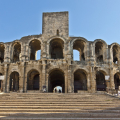ARLES ARENA (AMPHITHEATRE)
Arenas inspired by the Colosseum in Rome, a remarkable temple of games, a site classified as a historical monument in Arles.
At the gates of the Camargue, on the banks of the Rhone, is one of the largest amphitheaters in France. Visibly inspired by the Coliseum in Rome, the contemporary arena, built around 80 AD, has been the pride of Arles for nearly four centuries. A Roman colony since the 1st century B.C., Arles was a strategic commercial center for the Empire, which developed the city, embellishing it with new monuments and building ramparts to protect it. The Romans were builders; wherever they settled, they reproduced a small Rome and built theaters, terms, amphitheaters... This is particularly true in Arles: if the city is nicknamed the little Rome of Gaul, it is because it is the city with the most Roman buildings outside Rome.
The amphitheater of Arles is the most important building that remains of the ancient Roman colony. This stone colossus has all the characteristics of Roman constructions, notably the central arena surrounded by tiers, themselves protected by a low wall, and a real drainage system. However, what differentiates it from other great Roman monuments is the use of stone to build the building, where brick was usually the material of choice. The Colosseum in Rome, for example, was built with bricks dressed in marble. Today, only the brick remains, the marble having disappeared over the centuries. On the other hand, the façade of the Arles arena today presents its original aspect, and the visitor can admire the building as the Romans saw it. From an architectural point of view, the amphitheater is 21 meters high with two levels of sixty semicircular arches, separated by massive rectangular section pedestals. With a large axis of 136 meters length and a small axis of 107 meters, the amphitheater of Arles is slightly larger than that of Nimes, and occupies the twentieth rank among those of the Roman world.
To enter this monumental place, whose stones tell 20 centuries of history, is to take a leap into the past and be transported to Ancient Rome. You have to imagine the overexcited atmosphere that animated the public who came to attend the games. The amphitheater was a place of celebration and could accommodate up to 25,000 people, who flocked to see the live performances that were essential to the social life of the Romans. Entertainment is the essence of this building. When games were organized in the amphitheater, they always took place in more or less the same way. In the morning, wild animals were hunted in the arena: bears, wild boars, wild animals, rabbits, etc., were released and the gladiators were responsible for killing them. At noon, the condemned to death are executed in front of the public. But it is in the afternoon that the fervor really takes hold of the stands, filled with thousands of spectators who have come to attend the gladiatorial combats. Contrary to the generally accepted idea, popularized by the cinema, the killings are not systematic. If the fights are spectacular and bloody, the gladiators are, most often, professionals who volunteer and receive a salary. Their role is to entertain the crowd, so they keep the fun going with spectacular stunts. Injuries are common and sometimes very serious, but the killing remains occasional and takes place only at the express request of the public. This one is installed along the terraces, organized in a hierarchical way: the two nearest tribunes are allotted to the elite of the Roman colony; then comes the Roman people only made up of men; and, finally, the people whose social status is the least important, namely the women, the children, the slaves or the foreigners. The public attends the games for free, which are a real political tool and manipulation of the masses. Because the magistrates understood it well: a people entertained does not rebel. " Panem et circenses ", as the satirical poet Juvenal wrote to put forward the idea that it is enough to give the people bread and leisure so that they are satisfied.
The Arles arenas hosted games until the 4th century, when Christianity became the official religion of the Roman Empire and Emperor Theodosius abolished pagan festivals, including the games. At the fall of the Empire, the arena changed its function and was transformed into an urban fortress with the construction of four towers, nearly two hundred houses and even two chapels. It is a city in the city which develops and which will be finally destroyed at the beginning of the XIXe century, but whose ancient masonry still carries the traces. It is finally at the initiative of the writer Prosper Mérimée that this unique place is classified as a historical monument in 1840. Its first vocation, the reception of great spectacles, is again of topicality: the Roman games of the Ist century leave place today to the bullfights organized at the time of the two annual ferias, to the Camargue races or even to the musical spectacles. The arenas, recently the focus of a vast restoration and development plan (the work lasted ten years and cost 25 million euros), have since July 2013 recovered their original brilliance.
Did you know? This review was written by our professional authors.
Members' reviews on ARLES ARENA (AMPHITHEATRE)
The ratings and reviews below reflect the subjective opinions of members and not the opinion of The Little Witty.















Un bémol toutefois, lors des manifestations et des corridas en particulier, la signalétique est désordonnée .
A revoir , absolument